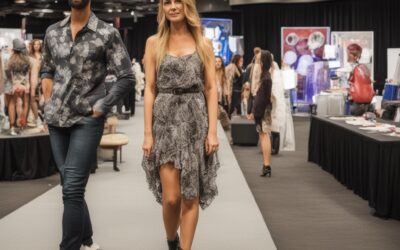Fashion shows are glamorous events that showcase the latest fashion designs from the biggest brands in the industry. However, behind the scenes, there is a lot of hard work, planning, and coordination that goes into making these shows a success. In this blog post, we will explore the business of fashion shows and what goes on behind the scenes.
The Pre-Show Preparations
Fashion shows are typically planned months in advance. The first step in planning a fashion show is to determine the theme, location, and date. Once the theme is decided, designers start working on their collections. They sketch their designs, source fabrics, and create samples to be showcased on the runway.
Once the designers have created their collections, they submit them to the fashion show producer for review. The producer then decides which designers will be featured in the show. They also determine the order in which the designers will showcase their collections on the runway.
The next step in the process is to select the models who will be walking in the show. This is done through a casting call where models are chosen based on their height, weight, and overall look. The chosen models then attend fittings to ensure that the clothing fits them perfectly.
The fashion show producer also works on selecting the hair and makeup team for the show. They coordinate with the team to ensure that the models’ looks complement the clothing being showcased.
The final step in the pre-show preparation is to promote the event. This is done through social media, advertising, and invitations to VIPs and celebrities.
The Day of the Show
On the day of the show, the backstage area is buzzing with activity. Designers and their teams are putting the finishing touches on their collections, models are getting their hair and makeup done, and organizers are making sure that everything runs smoothly.
The backstage area is divided into different zones. There is an area for the hair and makeup team, a dressing area for the models, and a staging area for the clothes. The designers and their teams have their own designated spaces where they can make final adjustments to the clothing.
During this time, the producer and their team are running final checks to make sure that everything is in place. They also oversee the rehearsals and ensure that the models are walking in the correct order and at the right pace.
The Show
The show itself is a carefully choreographed event. The models walk down the runway in a specific order and at a specific pace. The music is timed to match the clothing being showcased, and the lighting is designed to highlight the clothing and create a certain ambiance.
Throughout the show, the producer is backstage making sure that everything runs smoothly. They coordinate with the designers to make sure that the clothing is ready to go, and they ensure that the models are in the right place at the right time.
The After-Party
After the show, there is usually an after-party where designers, models, and VIPs can celebrate the success of the event. The after-party is an opportunity for everyone to network and make new connections in the industry.
Behind the Scenes Challenges
Despite the glitz and glamour of a fashion show, there are many challenges that can arise during the planning and execution of the event. One of the biggest challenges is the coordination of all the different teams involved in the event. This includes the designers, models, hair and makeup team, lighting crew, and music team. It can be difficult to get everyone on the same page and ensure that everything runs smoothly.
Another challenge is the unpredictability of the weather. Fashion shows are often held outdoors, which means that they are vulnerable to the weather. Rain, wind, or extreme temperatures can all impact the success of the event.
Finally, there is the challenge of making sure that everything is perfect on the day of the show. There are countless details that need to be taken care of, from the lighting to the music, to the clothing itself. Any mistake or mishap can have a significant impact on the success of the show.
In addition to these challenges, there are also broader issues facing the fashion industry as a whole. One of the most significant challenges is sustainability. The fashion industry is notorious for its environmental impact, with fast fashion and overproduction leading to significant waste and pollution. Many designers and fashion houses are now making efforts to create more sustainable collections and reduce their impact on the environment.
Another challenge facing the industry is diversity and inclusion. The fashion industry has been criticized for its lack of diversity, with many designers only showcasing clothing on thin, white models. However, in recent years, there has been a push for more diversity and inclusivity in the industry, with designers featuring models of different races, sizes, and ages.
Conclusion
Fashion shows are glamorous events that showcase the latest fashion designs from the biggest brands in the industry. However, behind the scenes, there is a lot of hard work, planning, and coordination that goes into making these shows a success. From the pre-show preparations to the day of the show, the fashion show producer and their team are responsible for making sure that everything runs smoothly.
Despite the challenges and issues facing the fashion industry, fashion shows remain an integral part of the industry. They provide a platform for designers to showcase their collections, and they generate excitement and interest in the latest fashion trends. With the fashion industry constantly evolving, we can expect to see new trends and innovations in fashion shows in the years to come.
We welcome any suggestions or questions. You can email us or contact us using the contact page.
You can also connect with us on the following social networks:









0 Comments